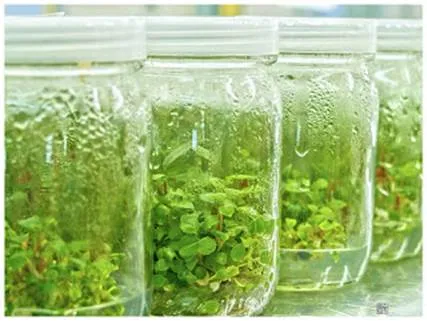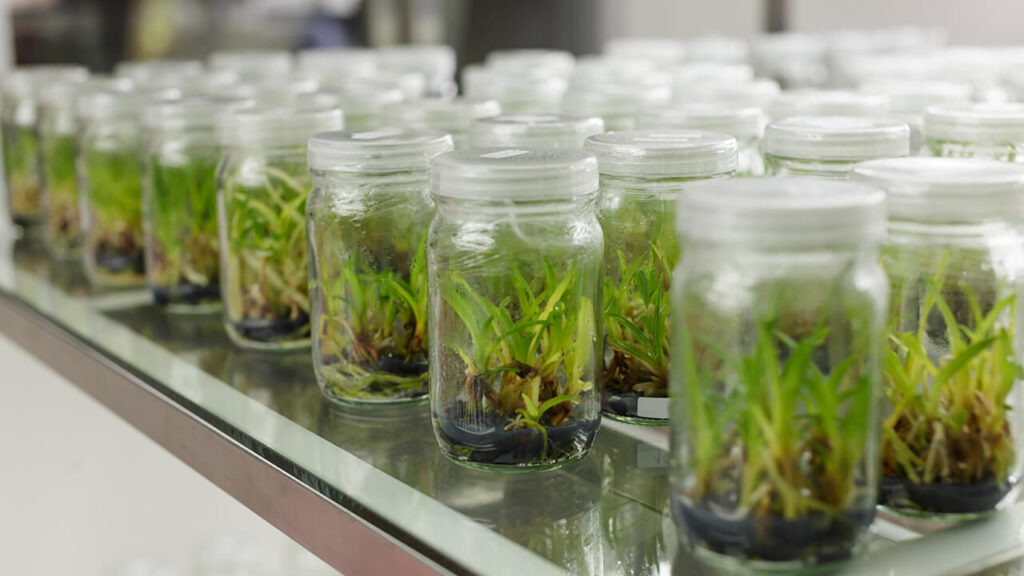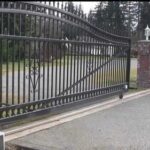

| Biotechnology 1. IntroductionThe success of Horticulture development hinges on selection of desired types of plants and their multiplications. Selection of desired types is based on evaluation of the quantitative and qualitative performance of plants and also in some cases their aesthetic appeal. Over the years, the horticulturists have developed various techniques for selection of desired types of plants and their multiplication. Recently interesting developments have taken place in the field of plant multiplication which involves culture of cells or tissues in laboratory.Traditionally, horticultural plants are multiplied by means of seeds (sexual propagation) or organs other than seeds (asexual or vegetative propagation). These organs are usually stems, leaves or roots. Though multiplication by seeds is the cheapest method, it suffers form certain disadvantages. Plants raised from seeds may not repeat good performance of mother plants. Many horticultural plants take a long time to produce seeds/fruits and many of them do not produce viable seeds or desired quality of seeds. Plants propagated vegetatively do not suffer from these disadvantages. However, vegetative propagation is rather a slow, time and space consuming process. Besides, it is usually infected with latent diseases. Some plants are also not amenable to vegetative method of propagation, for example, coconut, papaya, oil palm, clove etc.Therefore, scientists started a quest for an alternative method of plant propagation which could overcome the disadvantages of both the methods described above. After many trials and errors in the sixties, plant propagation by tissue culture method, which could overcome disadvantages of propagation by seeds or vegetative organs, was found commercially successful in the case of orchids. Subsequently, the method has been perfected for many other plants (Annexure A). The method (also known as micro-propagation) involves the culture of whole organism from cells or tissues or plant parts in glass (in vitro) on a defined medium under germ free conditions (sterile or aseptic), whereas conventional method of vegetative propagation (macro-propagation) involves culture of parts into whole organisms in natural conditions (in vitro). 2. Major advantages of Tissue-Culture :A large number of true to the type plants could be propagated within a short time and space and that too throughout the year. For example, it may be possible to propagate 2-4 lakhs of Tissue Cultured Plants (TCP) from a single bush of rose against 10 to 15 plants by vegetative means. Also, it may take about 2-4 months to produce healthy planting materials by tissue culture means, whereas a minimum of 6-8 months is required for most species by the latest method of vegetative propagation.● Tissue-culture could be a useful way of circumventing or eliminating disease which can accrue in stock plants.● TCPs may have increased branching and flowering, greater vigour and higher yield, mainly due to the possibility of elimination of diseases.● The method may succeed to propagate plants where seeds or vegetative propagation is not possible or difficult or undesirable.● The method saves space and energy. For example, 2500m2 of heated green house can be replaced by a climatised room of 10m2● The flexibility of nurseries can be improved. As the capital investment on mother plants is reduced to almost zero, it may be easier to adapt to changing conditions. Additionally, a better programming of the production is possible, because of the greater plant uniformity and the availability in the mass at any time.● Tissue culture can be utilised for breeding new varieties, preservation of germplasm and in vitro synthesis of metabolites. 3. Commercial prospectPropagation by tissue-culture offers good commercial prospect in ornamental plants, vegetables and also fruit plants, where value of the products is high. The technique has reportedly been successful in more than 100 species of plants. It has been estimated that more than 350 million TCPs are being produced annually through tissue culture.In India there are at least ten commercial organisations, which have developed technical competence for tissue culture with or without foreign tie-ups. The present installed capacity is about 50 million TCPs and the export is of the order of Rs. 5 crores. The working group appointed by the Ministry of Commerce has proposed an export target of Rs. 30 crores i.e. about 60 million TCPs over a five year period as against the present production of 8-10 million TCPs. Tissue culture method of propagation is highly labour intensive, 55-60% of the cost is on account of labour. India’s potential for export of tissue culture plants is rated very high because of abundant and cheap labour.The domestic market for TCPs, though nascent at present, is likely to develop, since tissue culture method of propagation can multiply an elite plant very rapidly. It is well known that one of the major constraints of horticultural development in our country is inadequate availability of quality planting materials. The demand of planting materials for major fruit crops has been estimated to be of the order of Rs. 175.4 crores during the Eighth Plan period.It may not be possible to meet this requirement by conventional nurseries. It would, therefore, be desirable to encourage commercial tissue culture labs to supplement the production of planting material by conventional means. 4. Tissue-Culture TechnologyThe details of technology are given in the Annexure O.5. Objective of Tissue-Culture ProjectThe primary objective of tissue culture projects could be propagation of large quantity of good quality planting materials from elite mother plants within a short period of time and space.6. Requirements of Tissue-Culture ProjectsIn line with the technology and objective of tissue cultural propagation, various facilities may also be required for such projects which are indicated below:6.1 Land:It is required to set up laboratory, mother plant unit, green house and office. Space may also be required for installing tube well / dug well and parking of vehicles.6.2 Source of technology:It would be evident from the general outline of the technology, given in the Annexure- O that propagation by tissue culture is much more sophisticated than other types of plant propagation; A tie-up with reputed laboratories, Indian or foreign, could be helpful. However, if well qualified and experienced staff are recruited, it may be possible to set up such units without any tie-up.6.3 Mother Plants:Mother Plants would serve as source of tissues (explant). Their performance should be tested before use as source of explant.In case of tie-up with well established laboratories, explants from tested mother plants could be available free of cost. Otherwise, collection, maintenance and testing of superior mother plants would be necessary.6.4 Laboratory:A tissue-culture laboratory generally comprises of media preparation room, media store room, inoculation room, growth room, culture transfer room, sterilization area, washing area, etc. The floor plan should be designed to promote maximum efficiency. The design should facilitate maintenance of optimum temperature, humidity, illumination and ventilation. Inside air of laboratory should be free from dust particles (Annexure D).6.5 Culture Media:The medium in which plant tissue grows is made up of various salts (containing all the major and micro elements essential for growth of plants), vitamins, sugars (usually sucrose) and growth regulators at appropriate concentration. Of the various constituents of the medium, the concentration of growth regulators is critical. The plant growth is virtually controlled by the ratio between two groups of growth regulators. Cytokinin group favours shoot growth, whereas auxin group favours root growth. The ratio varies between species and even between varieties within a specie.Sugar is the source of energy since tissues and shoots, while in the laboratory do not normally photosynthesize. Other nutrients perform their usual structural, functional and catalytic role. The agar is added to solidify the medium. Commercial tissue culture received major boost with the development of an improved medium in early sixties by Murashige and Skoog (Annexure B). 6.6 Equipments:Propagation by tissue-culture needs a good number of laboratory equipments. The various equipments and their functions are outlined below:i) Autoclave:Sterilisation of all glass apparatus and culture media can be accomplished by means of steam generated in the autoclave.ii) Analytical/Top Pan balances:For accurate measurement of various constituents of culture media, these balances would be required. Top pan balance is used for measuring larger quantities, while analytical balance is used for measuring smaller quantities.iii) pH meter:It is used for measuring and adjusting hydrogen ion concentration of the culture media or solution. Hydrogen ion concentration needs to be maintained accurately for achieving optimum growth of plants.iv) Laminar Air-flow cabinets:In these cabinets shoots developed on explants are separated from clusters and transferred to fresh medium under sterile condition. Inoculation can also be done here.v) Distillation sets:Water to be used for preparation of culture media should be free from all impurities and salts. This can be accomplished by double distillation of water.vi) Computer System:Computerisation of laboratory in the following aspects would be helpful. Production Planning Time scheduling of Sub-culturing. Quality control of plantlets. Growth room status. Material requirement. Market planning.vii) Air Conditioners with Stabilizers:Maintenance of desired temperatures in growth room, inoculation room/culture transfer room would be possible by air conditioning these areas.viii) Microscopes:a) Stereo Microscope : This would enable dissecting out small size meristem from shoot tips by removing the protective covers of leaf primodia.b) Compound microscope : This enables detection of bacteria and fungi in culture and plant tissues.ix) Bottle Washing Unit:Since a large number of bottles or vessels in which plants will be grown are required to be washed repeatedly before use, an automatic bottle washing unit would be helpful.x) Media Cooking Unit:Culture media, which contains all the essential nutrients, sugar and agar, needs to be cooked before use. A media cooking unit for a large scale commercial unit is, therefore, desirable.xi) Growth room racks:These hold the culture bottles in trays. They are mobile over a set of rails in order to maximise utilisation of space.xii) Trays:Supporting structure for culture bottles/vessels.xiii) Hatches :Pass through boxes used as gateway between clean area and semi-clean area for exchanging materials.xiv) Tube lights:Fluorescent tube lights are mounted on the bottoms of the shelves so that culture bottles containing explants/growing tissues receive requisite intensity of lights.xv) Dissecting Kits :These are necessary for separation of shoots and preparation of micro cuttings. Apart from the above, equipments such as refrigerator, rotary shakers, a stand by Genset, fire extinguisher, oven, air filters and furniture would be necessary. The office should have facilities such as Fax Machines, Telephone, Typewriters etc. 6.7 Green HouseIn tissue-cultural propagation, green house may be required primarily for the undernoted reasons: To raise and maintain mother plants so that growth of organs suitable for tissue culture is maximum particularly in case of ornamentals. To harden the plantlets gradually in natural environment. Green house will enable the control over light intensity and humidity, which is necessary for hardening of plants. However in case of 100% export- oriented projects, it may be possible to export the plantlets directly from the laboratory without subjecting them to hardening.6.8 Electricity:As it would be evident form the preceding paragraphs, no tissue-culture laboratory can operate without electricity. It is required for the following purpose: To illuminate tissues and shoots while they are in laboratory. To operate various equipments and facilities, which include air conditioners.6.9 Water:The various purposes for which water is essential are indicated below: Water for growing mother plants, hardening of plantlets, washing, canteen, toilets, etc. Distilled water for preparation of culture media and reagents.6.10 Raw materials:Raw materials required for tissue-culture project, apart from explant, are various constituents of culture media. These have already been discussed under paragraphs 4, 6.3 and 6.5.6.11 Skilled Manpower:Tissue-culture is a highly skilled operation. It would, therefore, be essential that laboratory and green house workers are well qualified and experienced in the technology. Their training in well established commercial laboratories would be helpful.All the requirements of tissue-culture projects, mentioned above could be made available from local resources.7. LocationTissue culture project for export may be located near to Airports. The site should be well connected with roads. Assured source of water and supply of electricity to the site are essential.8. Unit Size.The size of tissue-culture project could be expressed in terms of the capacity of production of tissue-cultured plants (TCPs). The projects so far set up in our county with assistance from financial institutions have production capacities, which vary from 1 million to 20 million TCPs per year. The size envisaged in the present model is 1.25 million TCPs per year. It has been estimated that, to produce 1.25 million TCPs, a laboratory of 5000 sq. ft. would be required. A green house facility of 5000 sq. ft. for maintenance of mother plants and hardening tissue cultured plants would be helpful. 9. Estimated Cost.The estimated cost for production of 1.25 million plants is indicated below: No.ParticularsCost (Rs. Lakhs)A)Fixed Cost iTissue culture laboratory including green house and green houseequipments (Annexure E)19.05iiLaboratory Equipments (Annexure F)27.29iiiFurniture, Fixtures and Office Equipments (Annexure H)6.26ivWater supply system (Annexure G)0.63vTraining1.00viConsultancy / Know-how fees2.00 56.23B)Contingency3.77 60.00C)Recurring Cost (Annexure K) Year 113.35 Year 225.55 Year 327.08D)Capital Cost (Rs.60.00 + Rs.13.35 Lakhs)73.35 The recurring expenditure of only 1st year may be capitalised. Thus, the total cost may amount to Rs. 73.35 lakhs.The estimated cost does not include cost of land. For 100% export-oriented units, land cost, may be included in the above estimate depending on merit of each case subject to a limit.However, it may be noted that above estimates are subject to actual drawings and rate analysis by competent architects for all civil structures and quotations from accredited dealers for all equipments, furniture, etc. |


